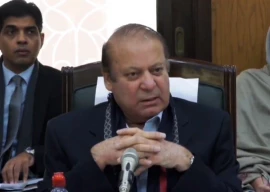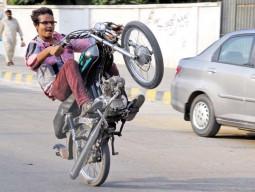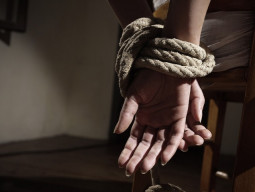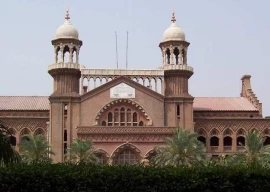
KARACHI:
There are over 900,000 Hazara living in Pakistan, a figure larger than the population of Washington DC. Yet this is a vulnerable community, besieged by anti-Shia violence on one side and drawing suspicion and indifference in equal measure on the other.
Old news, a Hazara might say, as a brief look at the community’s past reveals a tradition of persecution, of which yesterday’s attack in Quetta is but the latest atrocity.
The origins of the Hazara are disputed, though there are three primary theories. The Hazara could be of Turko-Mongol ancestry, descendants of an occupying army left in Afghanistan by Genghis Khan. A second theory goes back two millennia to the Kushan Dynasty, when Bamiyan in Afghanistan – home to the large statues blown up by the Taliban – was a centre of Buddhist civilisation. Subscribers to this idea point to the similar facial structure of the Hazaras with those of Buddhist murals and statues in the region.
The most widely-accepted theory is something of a compromise: that the Hazara are mixed-race. Certain Mongol tribes did travel to eastern Persia and what is modern-day Afghanistan, putting down roots and integrating with the indigenous community. This group then formed their own community which became the Hazara, with their distinctive facial features, sometimes termed Mongoloid, which bear the origins of their central Asian ancestry.
Either way the Hazara settled in central Afghanistan, though in the mid-19th Century their brutal history of persecution began when more than half their population was killed or forced into exile.
The Pashtun Amir Abdul Rehman, who the British termed Afghanistan’s Iron Amir during the Raj, invaded the Hazara homeland in the country’s central highlands, forcing them to give up land, and pushing many into exile in Balochistan.
There was already Hazara movement into British India by this point, with migrants working in labour-intensity jobs such as mining. Some Hazaras also came to Quetta during the 19th Century to work on the construction of Indian railways. However, the majority were forced to leave by Rehman’s ethnic cleansing.
But the Hazaras’ history is not exclusively one of victimhood. In 1907 British officer Colonel Claude Jacob raised a regiment made up solely of Hazaras, who had developed a reputation for martial strength, perhaps based on a romanticisation of their possible lineage to Genghis Khan.
The Hazaras who did not make the military cut found jobs as unskilled labourers, for despite their knowledge of agriculture, they owned no land in their new territory.
Quetta’s 1935 earthquake actually helped the Hazara community in some ways. The migration away from the city after the disaster opened up positions in semi-skilled labour, which led some Hazaras to become shopkeepers, tailors and mechanics.
The Second World War saw more Hazaras enlisted by the British Indian Army. Some thrived: one of them was General Musa Khan, who led Pakistan in the 1965 war against India.
Since Partition, however, the Hazaras have remained an underprivileged community. Currently between 500,000 and 600,000 live in Quetta, spread over two slums in the east and west of the city. A large proportion of their income is remittance payments from Iran, the Gulf, Europe and Australia.
Among the Hazara in Quetta are tens of thousands of new migrants escaping the wrath of the Taliban. Persecution of Hazaras persists in Afghanistan, where the Taliban have shown no let-up in their attack on Shias, burning villages and kidnapping community members, forcing further emigration into Pakistan.
In Pakistan, the sectarian violence also has a geopolitical context, with a deeply-embedded belief that the Hazara receive Iranian support. General Zia allowed state actors to support anti-Hazara groups for this reason. As mentioned by columnist Ejaz Haider in this newspaper recently, the view of the Hazara as Iranian proxies still persists in Balochistan.
Four days ago, rallies in Australia, the US, the UK, Austria, Norway, Denmark and Canada marked an international day of protest against the unending wave of attacks on Hazaras in Pakistan. The call has evidently not been heard. Indeed, approximately 250 Hazara citizens of Pakistan have been killed in the past three years.
Published in The Express Tribune, October 5th, 2011.
COMMENTS (71)
Comments are moderated and generally will be posted if they are on-topic and not abusive.
For more information, please see our Comments FAQ











































Hazaras are very talented people. My classmate was a hazara who got first position all the time. and I know many of them are very good at sports. And by the way, the areas they live are the cleanest in the city. we used to have them as friends and they were very nice people to hang out with.
Reality of the violence is the cultural differences between the Pashtun and Baluch Muslims and hazara community people.
@SJ u really like to add fuel to the already secterian-ized,why you wish to promote hatred? please come out of sectarianizm and become a muslim,a real one!
I belong to the Hazara community of Quetta. After reading the comments, I am so thankful to all those who really think that Hazaras are innocent and need justice.May Allah bless you all for raising your voices for haq. Even these small comments might make a difference in awakening everyone. Please do not stop. Help us in any way possible. Along with everything else we need slot of moral support too.
These Taliban has really proved that the world is Godless and they behave as such.
These Taliban has really proved that the world is Godless and they act as such.
Hazara and other minority discrimination and killing must stop. Thanks Tribune for voicing on behalf of innocent people. Love you
The President,PM and all PPP should resign! They cant protect their people!
@SJ i think u dont watch the electronic media or you watch and dont understand it! cant u see language riots all over Pakistan? Non Baluchis are being killed all over BaluchistaN pakhtuns are killed all over sawat and tribal areas In Pakistan,The divide is LINGUISTIC and not religious(as some medieval times mind people think)! What u r trying is to just start a fire of hatred between sects and nothing else! See how in a majority Sunni country of Pakistan, The President,PM and CM's too many parliamentarians are all shia, if u beleive they are not responsible for all this then u should go and live in fools paradise!
Hazaras are persecuted in Pakistan and in Afghanistan as well for a longer period. May be it's time for a separate 'Hazara nation'.
I am proud to be a follower of Islam (the greates religion) but i am ashamed of those humans who call themselves Muslims but kill but their fellow Muslims.... May Allah curse all the killers of innocent people. May Allah give strenght and courage to people of Hazara!!!
untill we stop using the terminology of good & bad taliban, good & bad Terroists, releasing Terrorists leaders / making way for the Terrorists to escape from prisons and negotiating with terrorists, such incidents won't be stopped.
@Bangladeshi: Are you serious or just being sarcastic?
I offer my gratitude and utmost reverence to your goodself and to your tireless efforts for the rights of people of Pakistan particularly for your todays column against the ruthless ethnic cleansing of Hazara community in Quetta. I believe that untill courageous journalists like you exist in Pakistan,nothing can be happened with Pakistan. May Allah safe you and our beloved country Pakistan. Thanks again for becoming the voice of the oppressed and dpressed people. However, i want to rectify here that we have nothing to do with Iran. Iran is using religion as a political tool. We Hazaras strongly detest Iranian imposed clergies on us. If you survey the Hazara community in Quetta you will hardly find any Hazara supporting Iran. In fact 90% of our people are against Iran.
With hundreds of recorded communities we must now start a campaign of acceptance of the great cultural diversity Pakistan is bestowed with instead of just the "majority" communities. All these smaller communities are providing their dues for the growth of our country & so need protection..
Hazaras suffer in Afghanistan too.No idea why. Sad.Very sad indeed.
@ Shah first of all get a reality check. How you can say that the riots in Pakistan are based on Language ? why certain people belonging to a specific community being targeted again and again? These riots all over the country are based on religious and political gains only. Please refrain from making frozen evaluations about such kind of tragic events. I think you are still living in the 1971 era relating every riot to language and ethnic color. Get your facts right and read some history books rather than making weird assumptions on such incident !! Peace
Mr. Imran Yusuf I back my brother M.A Changezi ... Yeah u really have to polish ur knowledge alot bcz v the hazaras rn't those of the past, v hv changed our lives, v rn't living in the slums. for ur kind info... v hv more than 80% literacy rate... wat v want is just... PEACE.
Hazara people have long faced violence in Afghanistan, suffering genocide, slavery, and forced displacement under a series of Afghan governments including the Taliban and Karzai’s regime. & now In Pakistan they are facing the serious problem of target killing. the government of Pakistan is failed to protect them. actually being Muslim & human beings all the Pakistanis are failed... at least they can protest against the Hazara killing In Quetta.
Please DONT try to make this violence a fuel for secterian clashes. People are being killed in Sawat,Karachi,Waziristan etc.. but no one termed that as sectarian, so please do not term killing of every hazara as ethinic,may be some foreign agents have done this who want to DE-stabilize Pakistan,like in Baluchistan and peshawar the foreign agents are killing innocent people by blasts.Let the judiciary and security departments investigate and dont try to point out someone before any inquiry is made!!
greetings
Being a member of the Hazara Nation, I would express my deep sorrow for the soul of the martyred innocent Hazaras in recent wild terrorist act. Hazaras are the people of courage, truthfulness, education, civilization and development. They have harmed no one throughout the history and have been the first among the most to give hands in the developmental and coordination of tribes and nations to put-forth Pakistan being Pakistani Citizen. Government of Pakistan, provincial government of balochistan and the rests of the tribes in Balochistan have always tried to ignore the excellencies, sacrifices and hard works of Hazaras by supporting or not raising the voices against the continued and frequent target killings.
Hazaras have been the role players and makers of the governments, Hazaras have served Pakistan on every ground, even then when it was 1950s when it was the peace time, 1960s when Pakistan faced a war against India, our people served as Jawans, ruled the armies and won wars for the pride and safety of beloved Pakistan. Pakistani government in any regime must not forget to support and secure Hazaras, Hazaras' rights as nations and welfare of Hazaras.
Thanks everyone for the reading and posting good valuable comments.
Same old language based violence .. termed as religious .. and the religious leaders of the victim's group gaining sympathy vote through it!
@SJ language based riots are all over country ,from Karachi to Baluchistan to NWFP .. please dont make the issue a SHIA-SUNNI war,please come out of medieval ages i think u always sit in company of the illeterate so-called allamahs who use all volence related issues to gain power!
Who are Hazara people ?
They are our brothers and sisters..... their blood is our blood and vice-versa.
This killing spry is not against Shia people… it is against Islam and against Pakistan.
I salute Hazara people for showing remarkable restrain even after losing so many loved ones.
Interesting..........I thought they were Chinese....
@AD: Afghanistan is fighting americans. nothing to do with Pakistan. Hazaras are killed its sad, but they are not killed by Pakistan Govt. Even in India Sikhs where killed by govt backed mobs. All over india you have race related crimes . especially in mumbai, where its very common for bihari hindus to be set on fire As for sunni shia violence, that happens all over the world, even in India . but in india shia sunni communal relations are far worse e.g in Lucknow
As for Bangladesh that was a civil war, much like Libya is today. Many thousands of muslims where killed by Bengali malitias both pro and anti pak non state muslim actors ? wars with India ? its funny how you try to distort events. Countries go to war,murder takes place in countries. India sent troops to fight hindus tamil tigers and created war in Nepal and Kashmir, non state actors maoist in india kill many hindus. Pakistan doesnt kill muslim, crime happens all over the world.pakistan is a muslim country so of course muslim make up the majority of victims of crime
@shah they follow shia school of thought makes them look like Iranians. How can you label them as Iranians? Even if you think its language based riots is it okay to kill 29 people on basis of language conflicts.you are living in a fool's paradise brother. If hazara massacre is related to language conflicts what about shia killings in parachinar ?? its not about being shia or sunni. One needs to have tolerance for other minorities. Live and let Live NOTHING ELSE !!!!
Hazaras should stop acting like IRANIANS and accept that they are more PAKISTANI.. Violence in Baluchistan is not religious but its is based on ethnic and language based difference and we must not make these language riots into SHIA_SUNNI matter! this violence is just language based riots! nothing else!!
@Crimeson blues Please its not just muslim each other every body in the world fight please read history and christian and jews history are more brutal than us.
@Bangladeshi “No Muslim can ever kill innocent people like that”. Zia-ul-Haq massacred thousands of Palestinian to evacuate a town near Jordan River. You rewarded him with Presidency and gave lip service to Palestinian people. @author: Nowhere in your article you articulated that Hazara’s are legal citizens of Pakistan just like a Sunni Pakistani and the state should offer them equal protection.
@Bangladeshi Muslims have been killing muslims since time immemorial.. read up on some islamic history please.
Hazaras are very nice peoples i have seen some in karachi they are very pakistani like any boddy else they enen live in hari pur hazara KP.
@ Banda-e-Iqbal,
The Hazara community who are living here at Quetta, are Pakistani Citizen b4 9/11 they were in Pakistan and even before invention they were living here. those who were belonging to Afghanistan were already been returned to their homeland, and some families are still living but 90 % are Pakistani Citizen who are living here.
HDP( Hazara Democratic Party ) Headed by Abdul Khaliq Hazara is the Hazara's Strong party getting 100 % Support of Hazara community, the party is really active for our society and no other individuals who are getting support of IRAN are not totally Hazara and NOR Pakistani, they are not representing the hazara community in Pakistan.
I respect your article on the community and your sympathy but there is just one mistake that I want to correct.Being a citizen of Quetta.The Hazara part of the town is not a slum but it is one of the most cleanest parts of the city.They are regarded as the cleanest community. As a matter of fact some people even regard Syedabad(Hazara dominated area) as Little europe for it's beauty and grace provided by the people
@A J Khan: The census conducted in 1998 was done without taking 9/11 into account. A massive population-shift occured after the Taliban brutality in Afthanistan during the era 1998-2001 and subesquently after 9/11 which dramatically effected the demographic statistics of the city.
Come and visit the city if it is possible for you. You will feel the population of the city including that of Hazars.
There may be few religious (Mullas) individuals who get support from Iran but most hazaras are peace loving people. We always blame those who get their fund from Iran on every hazaras news sites. Today those who get support from Iran completely lost their popularity in our community. Today Hazara Democratic Party gets more support from Hazara community.
Any way we the Hazara will not allow any one from our community to do something which is not good for the well-being of Pakistani citizen. We never take part in terrorist activities.
They are not being killed because they are Hazaras or have some particular facial features.They are being killed because they are Shias.In Pakistan the majority has time and again proved its narrow minded approach towards followers of other sects or religion .They spare no opportunity to victimize on the basis of religious beliefs.We ,the majority are following a path which will ultimately lead to our own destruction.
I request all the law enforcement agencies to provide security for hazara in Pakistan, though all the Hazara who are living in Quetta are Local citizen, and reflecting the strong and faithful, loyal and hardworking part of the quetta, even you can't compare the Hazara living site of quetta to other part, please please reflect this message to every one to provide and safe the Hazara all over country.
One of my close friends is part of the Hazara community. Back in the uni years he bailed early and left for U.S and then Canada where he applied for asylum for himself and his family. At that time I did not really understand why a Pakistani would need to seek asylum from Pakistan. I think @Salma is right and this may have been going on for a while. I totally agree with @Aftab. Personally, I do not know anybody who'd have a problem with someone being shia and/or hazara, sunni and/or balochi (please choose your own combination as you please) infact for that matter of any creed or religion. I have yet to meet anyone in Pakistan at least in my circle who discriminates on petty criteria. And yes dare I say this IS petty criteria. So, what disturbs and frustrates me more than ever is who are these idiots who are waging these devasting and embarassing acts on inoccent people? Of course, I know there are enough illitrate bafoons out there who would take it upon themselves to do "supposedly" right by "their" interpration of A book but perhaps these people either need to be institutionalised or weeded out.
Afghanistan (Read:Taliban) now joining hands with India as allies..means more and more innocent Hazaran will be killed.. along with all Pakistani's in general.. this is alarming for Pakistan's security, we are being placed under pressure for a reason - to weaken us from all sides.. these attacks are no coincidence! It's more than just ethnic cleansing, its a warning ..Taliban are still abound and we need Afghanistan to address their rogue army and put a stop to them - in order to achieve peace in the region...just my 2 cents
its the duty of our Govt to protect its citizen... no matter from where they came but now they are Pakistani national. Furthermore, no one being a true follower of Islam has the right to impose his own faith on others n its my request to the Govt of Pakistan that it must hang all the so called Mullahs who are creating sectarian violence on the name of Islam.
Pakistan since its birth has given nothing but death & destruction to the Muslims of subcontinent.First during partition thousand of Muslims got killed later it imposed three wars on India.Then came prosecution and killings of Bangla Muslims.When It was done it was time to take away peace of Kashmiri Muslims.Now Muslim of Baluchistan are being killed here n there.Hazaras & Ahmediya Muslims are being treated like carrots.And not to mention the Muslim Nation and its Neighbor Afghanistan. It is completely destroyed by Pakistani State & Non State Muslim actors.God save the subcontinent.
Through time immemorial India was home to the people persecuted in their home country. Jews came and lived in India peacefully for thousands of years. Parsis persecuted in Persia have been living peacefully. Tibetans are living peacefully without any problem. Hazaras lived peacefully in united India. Muslims never had any problem till British used divide and rule policy. We absorbed every culture without getting annihilated ourselves. On a lighter note India will be very happy to have Hazara in Kashmir in return for Gilani and others who wish to go and live in Pakistan.I am sure such exchange of population between India and Pakistan will be a win win situation.
I don't know much about the hazara community but one thing is sure that the ones that killed these innocent people are part of a bigger conspiracy. No muslim can ever kill innocent people like that. The media is fooling everyone if it says it is islamic militants. The "viscious" islamic militants actually pray 5 times a day and they even talk about brotherhood and are ready to give away their lives fighting americans. The americans tried their best to frame the mujahidins & are still trying. I am not trying to support terrorism here but its just not possible that any muslim would kill any one whether muslim or non-muslim like that, its just plain not possible.
I think we all are human either hazara , baloch or pashtoon. If Iqbal were a live i would tell him (your Mard-e-Momin) muslims killed their God by his bravery. They have killed the God by each bullet going through the heart of those hazaras who is targeted. It seems there is no God in Muslim land now. Otherwise God voice would come out from any heart of muslim living inside of their hearts.
Are we still proud to be muslim?
Divide and rule. First send counter-gangs of Mehsud to kill these innocents and then create rifts. It was all fine and dandy before US came in.
It is brutal and sadest demise in the country where is law and its inforcement is intact! dozens killed frequently, but not even a fake roar from this Government??? Hazara people are loyal Pakistanis and their protection is as much important as of Pakistani ministers families are protected...
There is no doubt over loyalties towards Pakistan of Hazaras. But the writer of the articles has misqouted one thing. He says they live in 2 slums at the corner of the Quetta. I haven't seen one of the 2 ends "Akhtarabad" but I have seen the other end "Mariabad" and it is in no way a slum. That's the truth. There are poor people in Hazara community but than there are too riches as well!
This Taliban plus sectarian rage against an innocent community in Baluchistan is a tragic event. If they were persecuted by Amir Rehman in Afghanistan (and are still hunted there) that is no excuse for them to feel unsafe in Pakistan, which is their homeland. The provincial and federal government should protect them at all costs. As mentioned earlier they are a beautiful addition to cultural diversity of our country.
Persecution of Hazara Tribe is most reprehensible and condemnable. They are being killed both for their ethnicity and Sect by the terrorists. They are being victimized in the name of religion and ethnicity by Sectarian outfits and Baloch militants.
This is somewhat half truth and mixed with other issues which are not the actaul cause of Hazara killing, the actual cause is that they are Shia and we should not camoflouge it even if it is unintentional. Moreover the Hazara settlement in Quetta is not a slum, it is the most beautiful and tidy part of the city reflecting the sense of citizenship of the community.
While agreeing with the compassion in the story and the empathy with the Hazara tribe , their brutal history of persecution , the population statistic in Pakistan appears to be far from reality. The author claims that there are 600,000 to 700,000 thousand Hazaras living in Quetta. As a matter of fact, the Population of Quetta as per 1998 census is 765,000 growing at a rate of 3% per year . Present day population of Quetta is not more than 1.2 Million in which majority are Pashtuns followed by Baloch/ brohi , Hazaras and Punjabi settlers . There is no doubt that Hazaras and Punjabies have settled in Quetta before the Balochs, majority of whom (Balochs/Brohi) came to Quetta when the Province of Balochistan was created in 1970..
This is what I believe. Some part of the Hazara tribe have the Kushan people as their ancestors. Thanks for the informative article.
Every community is important for Pakistan. Its time to covert Pakistan into United States of Pakistan where every community can govern their own states. No community or sect is superior. Equal rights is the only answer to problems of Pakistan.
The Hazaras are loyal to Pakistan.'Peace' is hallmark of this community. They are rich addition to cultural diversity of Pakistan. But quite unfortunate it is that Pakistan has lost its credibility in the world. Hazara need our moral support throughout Pakistan as from decade long history of Pakistan since 9/11, Hazaras are the most 'badly effected' community in Pakistan.